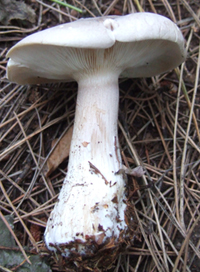It’s a great time of year to start going out foraging more often. It’s late summer with a good portion of rain to get things going. And Autumn is not too far away just round the corner. Many different species start to pop out and show their faces. The problem is though I do tend to get covered in insect bites that itch like crazy!
Besides these problems, I was fortunate enough to find two different Parasols not too far away from each other in and around my local park. The Parasol Mushroom (Macrolepiota procera) and the Shaggy Parasol (Chlorophyllum rhacodes – formerly Macrolepiota rhacodes). When I first published this post, the Parasols were both from the genus Lepiota, representing the larger specimens in this group. The name ‘Dappering’ is also used to label the majority of this species, but now the Shaggy Parasol has been chosen to stay in the Chlorophyllum genus.
The Parasol mushroom (M.procera) is fairly common and I found this one on the edge of parkland in thick grass (shared with nettles that added to my stings). It’s a mushroom you can’t really miss – standing their tall and proud shouting out it’s presence to the world. It was a solitary soul but sometimes you can find small and large groups of them together.

Note the Parasol mushroom’s distinctive central brown ‘bump’ and snake scale pattern on the stem
As the common name suggests, the open cap mimics the familiar shape of a parasol. When young, the cap is egg shaped and flattens out when it expands. The cap is a pale buff to white/creamy/brown colour with darker brown shaggy scales. Notably, it has a prominent bump on the top in the centre (umbo).
It’s long slender stem (slightly thicker near the base) has scaly snakeskin markings with a large (double) ring which can be moved up and down. Great fun. This scaly snakeskin appearance on the stem that helps in identifying it from a Shaggy Parasol which does not share this characteristic. Also note the smell, which is very distinctive (like ‘warm-milk as I’ve seen it written somewhere). The Shaggy Parasol on the other hand has no real strong smell at all.
This is an excellent mushroom to eat. Generally good as a fry up but I’ve heard they’re great deep-fried with dipping sauce on the side. Yum!
A few days before I had found myself a Shaggy Parasol (Chlorophyllum rhacodes) located on a patch of grass in the conifer wood close to the park (can also be found in grass gardens and shrubberies). It was kindly but indirectly pointed out to me by a passing little boy, shouting ‘MUSHROOM!’ to his mother who was very uninterested and replied ‘Don’t touch!’ Very wise words indeed – just leave it there – leave it for me (heh heh)!

Shaggy Parasol: Distinctive brown scales curling away from the white cap & thick bulbous base of stem. Notice the small compact shape of a younger specimen. (Locations: Front grass garden and conifer wood).
The rounded white cap (expanding to almost flat with age) has brown scales on top that curve upwards and out giving it a shaggy, torn appearance. The stem at the base is thick and rounded unlike the Shaggy Parasol which isn’t as bulbous.
This shaggy mushroom can be easily mistaken for the Parasol which is understandable. Good tips on how to identify this mushroom over the Parasol are the thicker, stockier appearance, no ‘snake-skin’ pattern on the stem and last but not least it’s colouring when bruised. If fresh, the stem and gills will bruise reddish-brown. Older specimens will have these reddish-brown tints appear naturally.
Edibilty-wise, this can be a very nice treat indeed – for some that is! It must be cooked, but it can disagree with some people and cause digestive upset or even a skin rash. It’s always best to try a little first and see how you go.
One last word of warning though – Never pick smaller sized parasols, or what appear to be parasols. You may by mistake obtain one of the smaller species of Lepiota (Dapperlings) which look like smaller versions of Parasols (around 7cm or less in diametre). Some of these are very poisonous and will cause you some serious grief. So, as a good rule with Parasol mushrooms only pick ones that are at least 12cm in diameter.
Update: North American poisonous lookalike:
As mentioned in the comments below (Nov 7, 2017), I thought it wise to mention the Green Spored Parasol (or False Parasol); Chlorophyllum molybdites, which is predominately most common in North America and causes gastrointestinal poisoning; such as diarrhea and/or vomiting a few hours after consumption. As of 2009 there has only been one record in the UK and I believe it may be still quite rare here. It looks very similar to edible Parasols (especially the Shaggy Parasol), but lacks the snakeskin pattern on the stem and has coarser cap scales. Fortunately a simple spore print test will reveal green spores. The gills, initially white often turn darker/greener with age.











